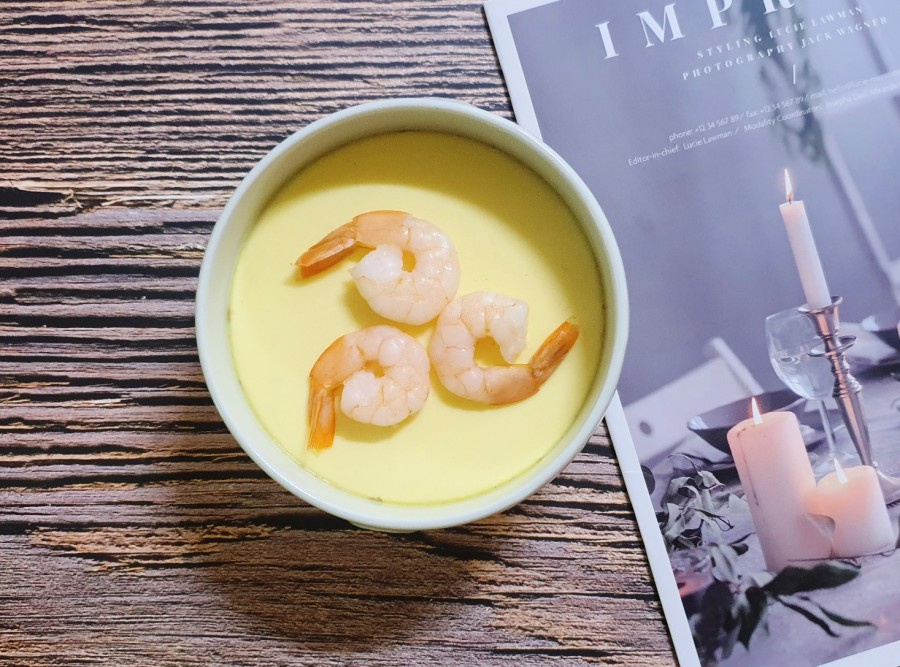Chawanmushi
Silky Smooth Japanese Steamed Egg Custard ‘Chawanmushi’ Recipe

Experience the exquisite tenderness of authentic Japanese Chawanmushi, a delicate steamed egg custard. This recipe features succulent shrimp as a topping, offering a delightful burst of flavor and a beautiful presentation. Perfect for a comforting and elegant dish.
Ingredients- 3 large eggs
- 180ml water
- 1 sheet konbu (dried kelp, approx. 5x5cm)
- 1 handful katsuobushi (bonito flakes, approx. 5g)
- 1 Tbsp sake or mirin (15ml)
- 1/2 tsp salt or soy sauce (2.5g)
- 3 frozen shrimp, peeled and deveined
Cooking Instructions
Step 1
In a pot, combine 180ml of water and the sheet of konbu. Bring to a gentle simmer over medium-low heat and cook for about 15 minutes to create a dashi broth. Be careful not to let the konbu release a sticky slime. For a cleaner taste, you can remove the konbu just before the water boils.

Step 2
Turn off the heat, remove the konbu, and add the handful of katsuobushi to the pot. Cover and let it steep for about 2 minutes to allow the bonito flakes to infuse their flavor into the broth. Avoid boiling the katsuobushi, as this can impart a bitter taste.

Step 3
Strain the broth through a fine-mesh sieve to remove the konbu and katsuobushi. Allow the strained broth to cool completely. It is crucial to use cold broth when mixing with the eggs; hot broth will cook the eggs prematurely.

Step 4
In a separate bowl, crack the 3 eggs and whisk them gently until the yolks and whites are just combined. Avoid whisking vigorously to prevent too much foam, which is key to a smooth custard.

Step 5
Pour the whisked eggs through a fine-mesh sieve again. Discard any chalazae (the stringy white parts) that are caught in the sieve. This step ensures a silky-smooth texture in the finished chawanmushi.

Step 6
Gently pour the cooled dashi broth into the strained egg mixture. Stir gently with a spatula or whisk until well combined.

Step 7
Add 1/2 teaspoon of salt or soy sauce to the egg mixture and season to taste. Adjust the amount of salt according to your preference. If you prefer a lighter color, use salt instead of soy sauce.

Step 8
Stir in 1 tablespoon of sake or mirin. This helps to eliminate any eggy odor and adds a subtle depth of flavor.

Step 9
Skim off any foam that has formed on the surface of the egg mixture using a spoon or the sieve. Foam can cause the surface of the steamed custard to become uneven or develop holes.

Step 10
Cover the heatproof ramekins (suitable for steaming) with plastic wrap. Pierce the plastic wrap 3-4 times with a toothpick to allow steam to escape during cooking.

Step 11
Fill a steamer pot or a deep pan with enough water so that it reaches just below the rim of the ramekins. Once the water is boiling, reduce the heat to medium and carefully place the covered ramekins into the steamer. Cover the pot and steam for about 10-12 minutes. Check the water level periodically to ensure it doesn’t evaporate completely.

Step 12
Thaw the frozen shrimp. Blanch the thawed shrimp in boiling water for 1-2 minutes, or until they turn a vibrant pink and are cooked through. Be careful not to overcook, as this will make the shrimp tough.

Step 13
Once the chawanmushi is set, carefully remove the ramekins from the steamer. Gently place the blanched shrimp on top of the custard, arranging them attractively. Ensure the custard is firm enough to hold the shrimp without them sinking.

Step 14
Your wonderfully smooth and fragrant Chawanmushi is ready! The delicate aroma of katsuobushi combined with the tender custard and the chewy shrimp creates a truly delightful experience. Enjoy it warm for the best taste.

Step 15
— (This step is redundant with step 1 and should ideally be removed or integrated. Preserving original input as instructed, but practically unnecessary) — Add a handful of katsuobushi after turning off the heat. Let it steep for about 2 minutes to extract the flavor.


